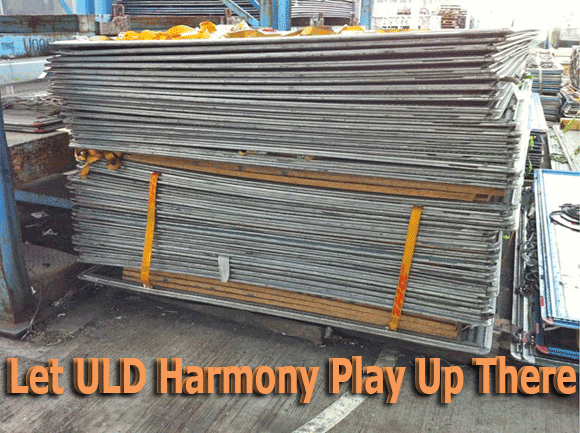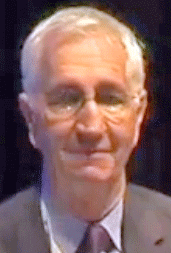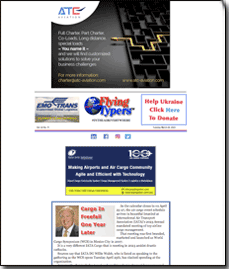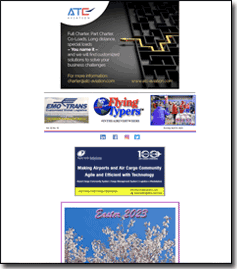
 |
 In
airports and airfreight, harmony in procedures and collaboration are essential
to establish a reasonable level of quality in service and ensure the respect
for the environment our day and age require. In
airports and airfreight, harmony in procedures and collaboration are essential
to establish a reasonable level of quality in service and ensure the respect
for the environment our day and age require.
Bob Rogers VP & Treasurer says, “here
at ULD CARE we get elated when we have a glimpse of such harmony.
“The recent coverage of ULD matters
in FlyingTypers
was certainly music to our ears!
“And a very big vote of thanks to
Marco Sorgetti for this extensive coverage of ULD, a subject that all
too often remains firmly in the closet.
“ULD Care fully concurs with Andre
Majeres statement that ULD are aircraft parts, and require the same degree
of care and attention as any other part, this is a drum that ULD CARE
and IATA have been banging for many years with, sad to say, limited results.
“But on top of the overriding issue
of flight safety – and never forget that there have been two major
fatal accidents directly resulting from substandard use of ULD in aircraft
loading – ULD CARE has also identified a number of other very significant
issues, and I would like to list these in the space we were granted by
FlyingTypers,” Rogers added.
Sustainablility
“This is a topic on everyone’s
lips these days. Now actually the ULD OEM’s have done a remarkable
job reducing the tare weight of containers, pallets and net by 40-50%
in the past 15-20 years, delivering significant fuel burn reductions to
the airlines and consequent benefit to the environment and air quality.
But when it comes to the “on the ground side” it is not such
a pretty sight, as the waste around ULD operations is extraordinary. We
can start with annual repair costs estimated to exceed USD$300 million,
and let us be clear, this is almost entirely the result of improper handling
of what are lightweight aircraft parts. And then there are cargo nets,
so often treated as “throw away” items in the general humdrum
of cargo ops and all too often ending up dumped in a corner or cut with
knives or driven over by a forklift, eventually ending a shortened lifecycle
in landfill (at the owners’ expense) . . . And
please don’t even get me started on cargo straps, again certified
aircraft parts (TSO C172), yet likely to make just a couple of trips before
ending up in a heap somewhere, an estimated 2.5 million such straps are
made every year, consuming around 22 Km of webbing and over 2,000 tons
of steel, year after year after year! Many sustainability improvements
require investment to yield savings, but around ULD it is actually just
a matter of reducing waste, with a bit of effort from all parties.”
Digitalization
“Over the past 4-5 years there has
been much talk about “Smart ULD” and indeed there have been
some significant innovations. But unfortunately we see very little change
to the way the movement of ULD into an “off airport” situation
is managed and monitored. ULD CARE’s analysis leads us to believe
that some 200,000 PMC make an off-airport move every month of the year,
a practice that is of huge benefit to all stakeholders in the air cargo
industry. Yet, when it comes to the ULD this practice leaves a great deal
to be desired, with a very large number of these off-airport moves not
being reported in an accurate and timely manner to their airline owners,
which are often half way around the world. ULD CARE estimates that around
8-10% of the global PMC fleet is “off the radar” and overdue
for return to their owner at any point in time. There is actually an IATA
standard document to record such transfers, RP 1654, the ULD Control Receipt,
which is the aviation equivalent of the maritime industry’s Equipment
Interchange Receipt. However, as a result of legacy IT and messaging protocols,
the UCR process frequently fails to deliver the required efficiency and
is long overdue for digitalization. ULD CARE is now well advanced on a
project to utilize modern IT such as App’s, hand held POS units
and API’s to move this five-decades old process into the 21st century.”
Efficiency
“One party’s efficiency should
not be at the expense of the other party and this is certainly true when
it comes to ULD’s. Unfortunately, it may seem efficient to conduct
cargo operations using inappropriate facilities and practices ignoring
the inevitable collateral damage to the ULD. With a few notable exceptions,
ULD operations are often carried out in very “unfriendly”
environments and almost always against the clock, with a very extensive
use of forklifts. The key to improving matters here lies in establishing
an industrywide awareness of the importance of knowing the difference
between the right and the wrong way when it comes to working with ULD’s,
and in this regard ULD CARE puts significant efforts and resources into
delivering a portfolio of solutions through its website (www.uldcare.com).
More often than it is actually perceived, the method in compliance is
also more efficient in the end.
“To wrap up, ULD are the oil that
lubricates the gears of air cargo: no ULD = no cargo!
“Just as an engine will seize up if
its oil is allowed to deteriorate or be contaminated, so the air cargo
industry will seize up without the proper degree of attention to the wellbeing
of the ULD upon which it depends. If you wish to fly and do not wish to
use care for your ULD’s you must make sure that you are a bird,
in all other circumstances ULD CARE is a must!”
Bob Rogers
|





